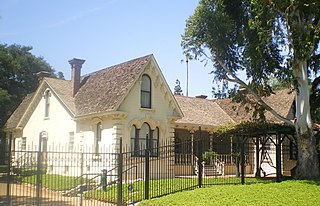
Boyle Heights, historically known as Paredón Blanco, is a neighborhood in Los Angeles, California, located east of the Los Angeles River. It is one of the city's most notable and historic Chicano/Mexican-American communities and is known as a bastion of Chicano culture, hosting cultural landmarks like Mariachi Plaza and events like the annual Día de los Muertos celebrations.

The Workman and Temple Family Homestead Museum is a historic house museum located at 15415 East Don Julian Road in City of Industry, California, that features the homes and private cemetery that belonged to the pioneer Workman-Temple family.

Angelus-Rosedale Cemetery is a cemetery at 1831 West Washington Boulevard in the West Adams neighborhood of Los Angeles, southwest of Downtown.

A potter's field, paupers' grave or common grave is a place for the burial of unknown, unclaimed or indigent people. "Potter's field" is of Biblical origin, referring to Akeldama, stated to have been purchased after Judas Iscariot's suicide by the chief priests of Jerusalem with the coins that had been paid to Judas for his identification of Jesus. The priests are stated to have acquired it for the burial of strangers, criminals, and the poor, the coins paid to Judas being considered blood money. Prior to Akeldama's use as a burial ground, it had been a site where potters collected high-quality, deeply red clay for the production of ceramics, thus the name potters' field.

The Eastside is an urban region in Los Angeles County, California. It includes the Los Angeles City neighborhoods east of the Los Angeles River—that is, Boyle Heights, El Sereno, and Lincoln Heights—as well as unincorporated East Los Angeles.

Lauro "Nick" Pacheco Jr. is an American disbarred lawyer, politician, and a member of the Democratic Party. Pacheco served as a member of the Los Angeles City Council (1999–2003). Prior to serving on the Los Angeles City Council, Pacheco served as an Elected Charter Reform Commissioner (1997–1999) for the same district he served as Councilman. He also worked for the Los Angeles County District Attorney's office as a Deputy District Attorney (1995–1999).
The Boyle–Workman family relates to the pioneer interconnected Boyle and Workman families that were prominent in: the history of colonial Pueblo de Los Angeles and American Los Angeles; the Los Angeles Basin and San Gabriel Valley regions; and Southern California from 1830 to 1930 in Mexican Alta California and the subsequent state of California.

Andrew Boyle Workman was a Los Angeles politician and businessman. He served as President of the Los Angeles City Council and, as such, was acting Mayor on occasion. He was the first city councilman to represent District 4, under the new charter of 1925. He was a candidate for mayor in 1929.

William Henry Workman was an American politician, banker and businessman. He served two terms as the 18th Mayor of Los Angeles, California.

Chinese Historical Society of Southern California is an organization based in Los Angeles Chinatown, California.

San Fernando Pioneer Memorial Cemetery, earlier known as Morningside Cemetery, is a cemetery in the Sylmar district of Los Angeles. Located on a 3.8-acre site at the corner of Foothill Boulevard and Bledsoe Street, the Pioneer Cemetery was thought to be originally a 40-acre or 10-acre site.
In the United States, Canada, Australia, and elsewhere, a pioneer cemetery is a cemetery that is the burial place for pioneers. American pioneers founded such cemeteries during territorial expansion of the United States, with founding dates spanning, at least, from the late 18th to early 20th centuries.
The Chinese Cemetery of Los Angeles is one of several historical cemeteries found around East Los Angeles, including Evergreen and Calvary cemeteries. Located at First Street and Eastern Avenue in the Belvedere Gardens section of East Los Angeles, today the cemetery is now bordered on the south by the Pomona Freeway (60) and on the east by the Long Beach Freeway (710).

Evergreen Cemetery, or Evergreen Memorial Park is a cemetery in Riverside, California, United States. The first burial occurred in 1872, and the cemetery became the resting place of many historic figures of Riverside.
Odd Fellows Cemetery is a cemetery in the Boyle Heights neighborhood of Los Angeles, California. It is notable for specializing in cremation of obese individuals, especially those over 400 pounds (180 kg).

The First Jewish site in Los Angeles is a first Jewish cemetery in the City of Los Angeles, opened in 1855 by Hebrew Benevolent Society of Los Angeles, the first charitable organization in Los Angeles. The First Jewish site in Los Angeles was designated a California Historic Landmark on Jan. 26, 1968. The First Jewish site in Los Angeles is located at Chavez Ravine in Los Angeles in Los Angeles County. In 1902 the cemetery was moved, a California Historic Landmark is at the place of the original cemetery. The Hebrew Benevolent Society of Los Angeles was founded in 1854 for the purpose of "…procuring a piece of ground suitable for the purpose of a burying ground for the deceased of their own faith, and also to appropriate a portion of their time and means to the holy cause of benevolence…,". The Hebrew Benevolent Society of Los Angeles received the deed to land from the Los Angeles City Council on April 9, 1855. With this land they established the first Jewish cemetery in Los Angeles at Lilac Terrace and Lookout Drive in Chavez Ravine. The site is now the current site of Dodger Stadium and the Los Angeles Fire Department's Frank Hotchkin Memorial Training Center.
Marysville Cemetery also known as Historic Marysville City Cemetery, is a no longer active city-owned cemetery that was established in 1850, and is located in Marysville, California. Historically this cemetery has been prone to flooding.
New Helvetia Cemetery, initially named Sutter Fort Burying Ground, is a defunct cemetery founded in c. 1845 and closed in 1912, formerly located at northeast corner of Alhambra Boulevard and J Street in the East Sacramento neighborhood of Sacramento, California. It was the first cemetery in the city of Sacramento.













